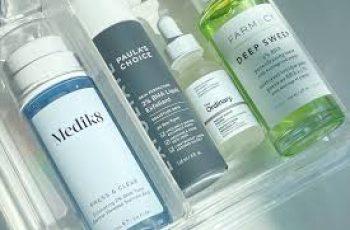
Can I Use Niacinamide and Azelaic Acid at the Same Time?
When it comes to layering skincare ingredients, knowing which ones work well together is key to achieving healthy, radiant skin.
Two powerful and popular actives often asked about are niacinamide and azelaic acid.
Both ingredients offer unique benefits and target different skin concerns. But can they be used together?
In this post, we’ll explore how each works, their benefits, and how to safely combine them for optimal results.
What is Azelaic Acid?
Azelaic acid is a naturally occurring acid found in grains like barley, wheat, and rye, as well as in yeast that naturally lives on the skin.
Though it’s often confused with alpha hydroxy acids (AHAs) or beta hydroxy acids (BHAs), azelaic acid has a unique chemical structure and works differently than these exfoliants.
It gently exfoliates the outer layers of dead skin cells, helping to clear clogged pores and remove dirt, excess oil, and debris. This makes it a great ingredient for reducing blackheads and blemishes.
Azelaic acid also boasts strong antibacterial properties. It combats Propionibacterium acnes (P. acnes), the bacteria responsible for acne flare-ups.
Its anti-inflammatory effects make it effective for calming rosacea and other inflammatory skin conditions, reducing redness and swelling.
In addition, azelaic acid targets hyperpigmentation and dark spots, brightening the complexion and evening skin tone for a clearer appearance.
This acid is packed with antioxidants, which help protect the skin against environmental damage caused by free radicals, such as pollution, UV exposure, and even indoor heating.
Azelaic acid is typically formulated in concentrations ranging from 15% to 20%, with lower percentages common in over-the-counter products and higher percentages reserved for dermatologist prescriptions.
If you want to explore azelaic acid further, check out our dedicated blog post diving into all its benefits and how to use it.
What is Niacinamide?
Niacinamide, also known as vitamin B3, is a water-soluble vitamin naturally found in foods like brewer’s yeast and cereals.
It’s an incredibly versatile ingredient loved for its ability to improve the skin’s overall health and appearance.
Niacinamide stimulates collagen production, leading to plumper, firmer skin with fewer visible fine lines and wrinkles.
It effectively targets hyperpigmentation, sun damage, and age spots by preventing melanosome transfer. This process helps stop pigment from moving to the skin’s surface and forming dark patches.
Regulating sebum production is another key benefit, making niacinamide excellent for those prone to oily skin and acne breakouts.
Niacinamide is rich in antioxidants, which protect skin from oxidative stress caused by UV rays, pollution, and other environmental aggressors.
Additionally, it has anti-inflammatory properties that reduce redness, blotchiness, and irritation while smoothing uneven skin texture.
Niacinamide also promotes faster skin cell turnover, helping to brighten the complexion and improve tone.
To learn more, you can check out our detailed niacinamide blog post for tips on how to incorporate it into your routine.
How Do You Use Niacinamide and Azelaic Acid Together?
The best way to use niacinamide and azelaic acid together depends on the formulations they come in and your skincare routine’s layering order.
A general rule is to apply products with the thinnest consistency first, followed by thicker creams or oils. This allows for better absorption and effectiveness.
Azelaic acid is commonly found in toners, serums, or gels, often lighter in texture.
Niacinamide usually appears in serums, sometimes combined with hydrating ingredients to boost moisture levels after using exfoliating toners.
By applying azelaic acid first, you help clear away dead cells and impurities, preparing your skin for niacinamide’s soothing and hydrating benefits afterward.
Can You Mix Azelaic Acid with Niacinamide?
Yes, you absolutely can! In fact, combining these two ingredients is an excellent way to address multiple skin concerns while reducing the risk of dryness often caused by chemical exfoliants.
Because they work in complementary ways, there’s generally little to no side effects when layering niacinamide and azelaic acid—provided your skin tolerates the combination well.
Everyone’s skin is unique, though, so if you notice any irritation or discomfort, it’s wise to pause use and consult a dermatologist for tailored advice.
Should I Use Azelaic Acid or Niacinamide First?
This depends on the product texture and your skincare routine order.
Azelaic acid is often found in lighter formulations like toners or gels, which should be applied earlier in your routine right after cleansing.
Niacinamide, frequently present in serums, usually has a slightly thicker consistency and can be applied next to help hydrate and strengthen the skin barrier.
Niacinamide’s humectant properties draw moisture to the skin and help lock it in, which is essential after using an exfoliant like azelaic acid.
Maintaining a strong lipid barrier is vital for protecting your skin against free radicals, UV rays, pollution, and other environmental aggressors.
What Should You Not Mix with Niacinamide?
You may have heard old advice that niacinamide shouldn’t be used with vitamin C because they cancel each other out or cause irritation.
This idea stems from outdated studies when vitamin C formulations were unstable and prone to degrading when mixed with other ingredients.
However, modern skincare science has improved vitamin C stability drastically. Many brands now safely combine niacinamide and vitamin C in their products.
Therefore, don’t shy away from using both if your products are formulated properly. Just monitor your skin’s reaction and adjust if you notice sensitivity.
When Should Azelaic Acid Be Used in Your Routine?
Azelaic acid can be used twice daily once your skin builds tolerance, but timing depends on the product type.
Thinner formulations like toners or gels are applied early in your routine, just after cleansing.
Thicker creams or moisturizers containing azelaic acid should be applied later, after serums, to avoid creating a barrier that blocks absorption of other actives.
Azelaic acid is generally well-tolerated by most skin types, making it easy to integrate into daily skincare.
If you’re unsure about sensitivity, performing a 24-hour patch test before full-face application can help prevent irritation or unwanted reactions.
Final Thoughts
Niacinamide and azelaic acid are two versatile, powerful ingredients that can transform your skin when used thoughtfully together.
They complement each other by targeting acne, hyperpigmentation, inflammation, and hydration simultaneously.
The key is layering correctly—usually azelaic acid first (if in a lighter formulation), followed by niacinamide serum. Always listen to your skin and adjust usage frequency if irritation occurs.
If you have any questions or want personalized skincare advice, don’t hesitate to reach out on Instagram—we’re here to help you achieve your best skin!


